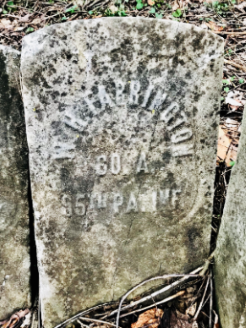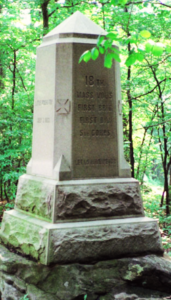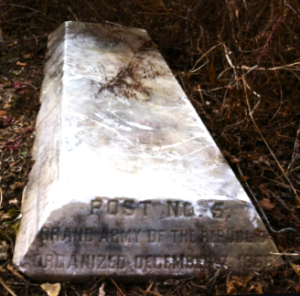Title: Army Corporal, Civil War; hatter
Birthdate: October 8, 1830
Death Date: January 25, 1887
Plot Location: Section 205, Lot 1, southwest part

A Hollywood screenwriter making up a fictitious name for the son of a fabulously wealthy oil baron could not have found a more prosperous-sounding name than this. However, the real Watson Holbrook Farrington was one of several not-so-well-to-do children in a farm family whose parents had the simple names of Harvey and Nancy.
Early Years
Watson began life in Wrentham, Massachusetts. It was named after a village in England, and is the only incorporated town with that name in the United States. (Had the townspeople kept the original name, it would have been the only town in the U.S. named Wollomonopoag, but Wrentham was easier to spell and pronounce.)
There were at least seven children born but three didn’t live past two years of age. All were boys except the youngest. Watson became the husband of Elizabeth Kingsbury in 1852. Three years later Harvey died, so the young couple and their two little boys moved in with Nancy. Watson had been a bootmaker but came home to run his father’s farm. They had another boy in 1858 and probably sold the farm a few years later.
War Years
The Farringtons had a daughter in 1861, then two more boys were born after Watson returned from the Civil War. He marched south in August, 1861 with Company I of the 18th Massachusetts Infantry. His regiment was part of the Peninsula Campaign of 1862, but he was wounded at the Second Battle of Bull Run on August 30. He spent about eight months recuperating, returning to his company before the Battle  of Gettysburg. The 18th brought 281 men to the field, losing just one killed, 23 wounded and 3 missing. This monument in their honor was erected on the battlefield by the state of Massachusetts in 1885.
of Gettysburg. The 18th brought 281 men to the field, losing just one killed, 23 wounded and 3 missing. This monument in their honor was erected on the battlefield by the state of Massachusetts in 1885.
In return for reenlisting in early 1864 he received a “bounty” or bonus pay, plus a month’s furlough in February. Corporal Farrington then returned to Virginia and saw action in several battles that spring. They pushed south into some heavy fighting as part of the Richmond-Petersburg campaign that began in June. His unit, along with several other disbanded regiments, were merged into the 32nd Massachusetts Infantry in the fall.
They were in the middle of nine months of trench warfare around the Confederate capital. Finally, at the end of March, 1865, the 32nd joined in pursuing the rebel troops as they retreated to Appomattox Court House. They witnessed the surrender of battle flags and weapons by the Army of Northern Virginia on April 9.
Post-war Years
The hostilities were over but it would be more than two months before Watson returned to his family and a job making boots. His mother had spent her last years with them during the war, but the state census of 1865 shows they were now sharing their home with Elizabeth’s widowed father.
Hundreds of thousands of veterans needed to heal from the trauma of war, a pattern that would be repeated after future conflicts. An organization called the Grand Army of the Republic quickly grew  to national prominence, and Watson joined the local post that was organized in Wrentham. He may have worn the GAR medallion, shown here. The men came together to honor their fallen comrades and provide care for their dependents. Eventually the GAR became a powerful political force lobbying for pension benefits.
to national prominence, and Watson joined the local post that was organized in Wrentham. He may have worn the GAR medallion, shown here. The men came together to honor their fallen comrades and provide care for their dependents. Eventually the GAR became a powerful political force lobbying for pension benefits.
After a while, Watson changed the focus of his work from the feet to the head. He left his boot making skills to pursue a new career as a hatter. (The term referred to one who made men’s hats, while women’s hats were made by a milliner.)
Massachusetts was the center of American hat making in the mid-1800s, but production was shifting south to Philadelphia. After their second son, Ernest, died of typhoid fever in 1874, Watson decided to go where the jobs were.
Part of the reason may have been that their marriage ended, and part of the motivation for moving was that his sister and her husband were living in Philly. He arrived In the late 1870s just as the world’s largest hat maker, the John B. Stetson Company, was expanding its operations.
It’s not known if that’s where Watson worked, but there were plenty of options. By 1883 there were 66 makers of men’s and boy’s hats in the city, employing 1800 workers. Stetson’s factory was in the industrial section of Kensington. Others were in Callowhill, within walking distance of Watson’s house at 417 North 9th Street. While there he joined the U.S. Grant Post #5 of the Grand Army of the Republic.
 “Chronic inflammation of the lungs” was what ended his life in 1887. Unlike pneumonia it is caused not by infection but by airborne irritants. Sometimes called “farmer’s lung,” it may have arisen from his working with fabrics
“Chronic inflammation of the lungs” was what ended his life in 1887. Unlike pneumonia it is caused not by infection but by airborne irritants. Sometimes called “farmer’s lung,” it may have arisen from his working with fabrics  in a hat factory. His fellow vets at the GAR arranged for his burial here at Mount Moriah because they owned a lot in Section 205, marked by this large slab. They paid for his stone, shown above, but incorrectly stated his service was with Company A of the 95th Pennsylvania Infantry.
in a hat factory. His fellow vets at the GAR arranged for his burial here at Mount Moriah because they owned a lot in Section 205, marked by this large slab. They paid for his stone, shown above, but incorrectly stated his service was with Company A of the 95th Pennsylvania Infantry.
Being single seemed to have passed from father to sons; all five of them were lifelong bachelors. Four of them lived with their mother as adults and are listed on her gravestone in Wrentham. Their oldest son lived in New Mexico. Their daughter married in 1890 and her family all lived and died in Massachusetts.

Support the Friends of Mount Moriah
Help us in our mission to restore and maintain the beautiful Mount Moriah Cemetery by donating to our cause or volunteering at one of our clean-up events.

